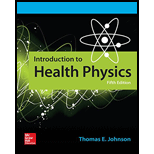
Concept explainers
A counting system has a background of 360 counts during a 20-minute counting period. What is the lower limit of detection with this system for counting times of
(a) 2 minutes?
(b) 20 minutes?
(c) 200 minutes?
(a)
Lower limit of detection for counting times of 2 min
Answer to Problem 9.14P
Lower limit detection is 24 cpm.
Explanation of Solution
Given:
Time during which gross count was made,
Background count,
Time during which background count was made,
Formula used:
Background counting rate,
Lower limit of detection,
Calculation:
Background counting rate,
Lower limit of detection,
Conclusion:
Lower limit detection is 12 cpm.
(b)
Lower limit of detection for counting times of 20 min
Answer to Problem 9.14P
Lower limit detection is 4.6 cpm.
Explanation of Solution
Given:
Time during which gross count was made,
Background count,
Time during which background count was made,
Formula used:
Background counting rate,
Lower limit of detection,
Calculation:
Background counting rate,
Lower limit of detection,
Conclusion: Lower limit detection is 4.6 cpm.
(c)
Lower limit of detection for counting times of 200 min
Answer to Problem 9.14P
Lower limit detection is 658 cpm.
Explanation of Solution
Given:
Time during which gross count was made,
Background count,
Time during which background count was made,
Formula used:
Background counting rate,
Lower limit of detection,
Calculation:
Background counting rate,
Lower limit of detection,
Conclusion:
Lower limit detection is 3.3 cpm.
Want to see more full solutions like this?
Chapter 9 Solutions
Introduction To Health Physics
- pls help on thesearrow_forward20. Two small conducting spheres are placed on top of insulating pads. The 3.7 × 10-10 C sphere is fixed whie the 3.0 × 107 C sphere, initially at rest, is free to move. The mass of each sphere is 0.09 kg. If the spheres are initially 0.10 m apart, how fast will the sphere be moving when they are 1.5 m apart?arrow_forwardpls help on allarrow_forward
- 19. Mount Everest, Earth's highest mountain above sea level, has a peak of 8849 m above sea level. Assume that sea level defines the height of Earth's surface. (re = 6.38 × 106 m, ME = 5.98 × 1024 kg, G = 6.67 × 10 -11 Nm²/kg²) a. Calculate the strength of Earth's gravitational field at a point at the peak of Mount Everest. b. What is the ratio of the strength of Earth's gravitational field at a point 644416m below the surface of the Earth to a point at the top of Mount Everest? C. A tourist watching the sunrise on top of Mount Everest observes a satellite orbiting Earth at an altitude 3580 km above his position. Determine the speed of the satellite.arrow_forwardpls help on allarrow_forwardpls help on allarrow_forward
- 6. As the distance between two charges decreases, the magnitude of the electric potential energy of the two-charge system: a) Always increases b) Always decreases c) Increases if the charges have the same sign, decreases if they have the opposite signs d) Increases if the charges have the opposite sign, decreases if they have the same sign 7. To analyze the motion of an elastic collision between two charged particles we use conservation of & a) Energy, Velocity b) Momentum, Force c) Mass, Momentum d) Energy, Momentum e) Kinetic Energy, Potential Energyarrow_forwardpls help on all asked questions kindlyarrow_forwardpls help on all asked questions kindlyarrow_forward
 University Physics Volume 1PhysicsISBN:9781938168277Author:William Moebs, Samuel J. Ling, Jeff SannyPublisher:OpenStax - Rice University
University Physics Volume 1PhysicsISBN:9781938168277Author:William Moebs, Samuel J. Ling, Jeff SannyPublisher:OpenStax - Rice University College PhysicsPhysicsISBN:9781938168000Author:Paul Peter Urone, Roger HinrichsPublisher:OpenStax College
College PhysicsPhysicsISBN:9781938168000Author:Paul Peter Urone, Roger HinrichsPublisher:OpenStax College Modern PhysicsPhysicsISBN:9781111794378Author:Raymond A. Serway, Clement J. Moses, Curt A. MoyerPublisher:Cengage Learning
Modern PhysicsPhysicsISBN:9781111794378Author:Raymond A. Serway, Clement J. Moses, Curt A. MoyerPublisher:Cengage Learning Physics for Scientists and Engineers: Foundations...PhysicsISBN:9781133939146Author:Katz, Debora M.Publisher:Cengage Learning
Physics for Scientists and Engineers: Foundations...PhysicsISBN:9781133939146Author:Katz, Debora M.Publisher:Cengage Learning College PhysicsPhysicsISBN:9781285737027Author:Raymond A. Serway, Chris VuillePublisher:Cengage Learning
College PhysicsPhysicsISBN:9781285737027Author:Raymond A. Serway, Chris VuillePublisher:Cengage Learning Principles of Physics: A Calculus-Based TextPhysicsISBN:9781133104261Author:Raymond A. Serway, John W. JewettPublisher:Cengage Learning
Principles of Physics: A Calculus-Based TextPhysicsISBN:9781133104261Author:Raymond A. Serway, John W. JewettPublisher:Cengage Learning





